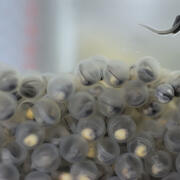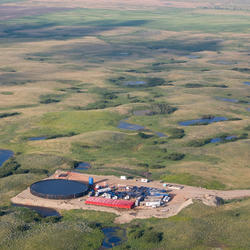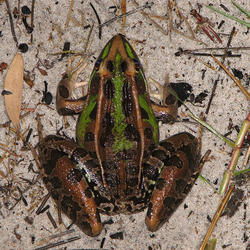Behavioral Toxicology Laboratory — Columbia, Missouri. Screen shot of a computer monitor from a video recording setup from a swimming behavior experimental swimming behavior assay system. U.S. Geological Survey (USGS) scientists can record swimming activity of multiple treatments simultaneously in the swimming behavior assay.
Holly Puglis, PhD
Dr. Holly Puglis is a Research Ecologist with the Columbia Environmental Research Center.
Science and Products
Behavioral Toxicology Core Technology Team
Do Trace Metal Concentrations in the Upper Columbia River Affect Early Life Stage White Sturgeon?
Energy Integrated Science Team
Clothianidin Exposure Associated with Changes in Tadpole Behavior
Water chemistry and biological data of Rainbow Trout following aquatic exposure to weathered wildland fire retardants after application to substrate
Biological and chemical data from laboratory toxicity exposures of wildland fire retardants to Rainbow Trout
Biological and chemical data from attenuated and pulsed exposures of fire chemical to fish
Biological and chemical data from chloride bioassays with native wetland species in natural and reconstituted Prairie Pothole waters
Behavioral Effects of Copper on Larval White Sturgeon
Widespread Legacy Brine Contamination from Oil Shales Reduces Survival of Chorus Frog Larvae-Data

Behavioral Toxicology Laboratory — Columbia, Missouri. Screen shot of a computer monitor from a video recording setup from a swimming behavior experimental swimming behavior assay system. U.S. Geological Survey (USGS) scientists can record swimming activity of multiple treatments simultaneously in the swimming behavior assay.
Toxicity of wildland fire retardants to rainbow trout in short exposures
Ammonia and aquatic ecosystems – A review of global sources, biogeochemical cycling, and effects on fish
Toxicity of wildland fire-fighting chemicals in pulsed exposures to rainbow trout and fathead minnows
Chloride toxicity to native freshwater species in natural and reconstituted prairie pothole waters
Predicting the spatiotemporal exposure of aquatic species to intrusions of fire retardant in streams with limited data
Copper concentrations in the upper Columbia River as a limiting factor in White Sturgeon recruitment and recovery
Effects of the neonicotinoid insecticide clothianidin on southern leopard frog (Rana sphenocephala) tadpole behavior
Behavioral effects of copper on larval white sturgeon
Potential toxicity of dissolved metal mixtures (Cd, Cu, Pb, Zn) to early life stage white sturgeon (Acipenser transmontanus) in the Upper Columbia River, Washington, United States
Widespread legacy brine contamination from oil production reduces survival of chorus frog larvae
Sensitivity of lake sturgeon (Acipenser fulvescens) early life stages to 2,3,7,8-tetrachlorodibenzo-P-dioxin and 3,3′,4,4′,5-pentachlorobiphenyl
Quantifying fish swimming behavior in response to acute exposure of aqueous copper using computer assisted video and digital image analysis
Non-USGS Publications**
**Disclaimer: The views expressed in Non-USGS publications are those of the author and do not represent the views of the USGS, Department of the Interior, or the U.S. Government.
Science and Products
Behavioral Toxicology Core Technology Team
Do Trace Metal Concentrations in the Upper Columbia River Affect Early Life Stage White Sturgeon?
Energy Integrated Science Team
Clothianidin Exposure Associated with Changes in Tadpole Behavior
Water chemistry and biological data of Rainbow Trout following aquatic exposure to weathered wildland fire retardants after application to substrate
Biological and chemical data from laboratory toxicity exposures of wildland fire retardants to Rainbow Trout
Biological and chemical data from attenuated and pulsed exposures of fire chemical to fish
Biological and chemical data from chloride bioassays with native wetland species in natural and reconstituted Prairie Pothole waters
Behavioral Effects of Copper on Larval White Sturgeon
Widespread Legacy Brine Contamination from Oil Shales Reduces Survival of Chorus Frog Larvae-Data

Behavioral Toxicology Laboratory — Columbia, Missouri. Screen shot of a computer monitor from a video recording setup from a swimming behavior experimental swimming behavior assay system. U.S. Geological Survey (USGS) scientists can record swimming activity of multiple treatments simultaneously in the swimming behavior assay.
Behavioral Toxicology Laboratory — Columbia, Missouri. Screen shot of a computer monitor from a video recording setup from a swimming behavior experimental swimming behavior assay system. U.S. Geological Survey (USGS) scientists can record swimming activity of multiple treatments simultaneously in the swimming behavior assay.
Toxicity of wildland fire retardants to rainbow trout in short exposures
Ammonia and aquatic ecosystems – A review of global sources, biogeochemical cycling, and effects on fish
Toxicity of wildland fire-fighting chemicals in pulsed exposures to rainbow trout and fathead minnows
Chloride toxicity to native freshwater species in natural and reconstituted prairie pothole waters
Predicting the spatiotemporal exposure of aquatic species to intrusions of fire retardant in streams with limited data
Copper concentrations in the upper Columbia River as a limiting factor in White Sturgeon recruitment and recovery
Effects of the neonicotinoid insecticide clothianidin on southern leopard frog (Rana sphenocephala) tadpole behavior
Behavioral effects of copper on larval white sturgeon
Potential toxicity of dissolved metal mixtures (Cd, Cu, Pb, Zn) to early life stage white sturgeon (Acipenser transmontanus) in the Upper Columbia River, Washington, United States
Widespread legacy brine contamination from oil production reduces survival of chorus frog larvae
Sensitivity of lake sturgeon (Acipenser fulvescens) early life stages to 2,3,7,8-tetrachlorodibenzo-P-dioxin and 3,3′,4,4′,5-pentachlorobiphenyl
Quantifying fish swimming behavior in response to acute exposure of aqueous copper using computer assisted video and digital image analysis
Non-USGS Publications**
**Disclaimer: The views expressed in Non-USGS publications are those of the author and do not represent the views of the USGS, Department of the Interior, or the U.S. Government.





